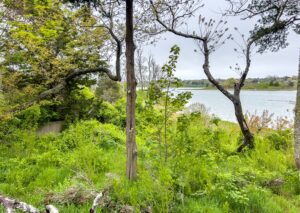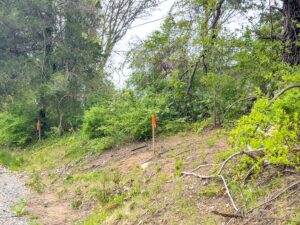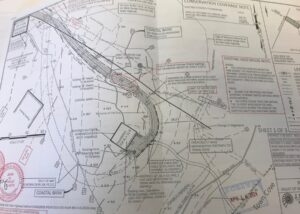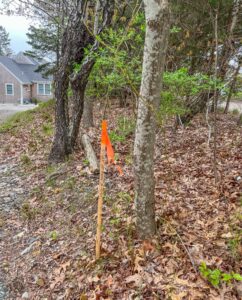EASTHAM — Steven and Cathy Sanders’s deed to 75 South Eastham St. includes a right-of-way allowing them access to Town Cove on the other side of Route 6. The couple’s plan to improve that right-of-way — overgrown for lack of use over decades — has gone from the town’s conservation commission to court and back again since 2021.

This spring, the commission decided to stand by its original determination that the improvements proposed would damage the coastal bank, salt marsh, and related protected areas. Without the commission’s approval, the debate will resume in Barnstable Superior Court.
The 12-foot-wide right-of-way runs through two waterfront properties, one at 670 State Hwy. owned by Maryann and Richard Rossignol and the other belonging to Gary and Anne Boudreau at 690 State Hwy.
Three years ago, the Sanderses proposed to clear a swath and create a gravel driveway that would run 280 feet from Route 6 to the cove; build a storage shed for their kayaks and other equipment on the foundation of an old collapsed fish shack on the Rossignol property; and construct a 75-foot-long raised wooden walkway through the salt marsh.
The Boudreaus and Rossignols were vehemently opposed to these improvements.

The right-of-way dates to 1918, and the Sanders deed isn’t the only one that conveys it. Deeds for five or six other properties on South Eastham Street also include that right, although the owners of those properties so far have not indicated an interest in exercising theirs.
During the 2021 hearings, the proposed driveway was trimmed to a four-foot-wide walkway, but other elements of the plan remained the same. The conservation commission in November 2021 denied permission for the work in wetlands and buffer zones.
The Sanderses appealed that denial in Barnstable Superior Court. The case was put on hold last fall and sent back to the commission to see whether a modified plan could win its approval.
The new plan calls for a four-foot-wide walking path from the highway to the marsh; construction of a storage shed to be placed on the fish shack foundation; and creating a meandering foot path, instead of the raised walkway, through the marsh to the cove.

After a series of hearings, the commission again denied the proposal, but not without debate.
At an April 23 hearing, when the Sanderses’ attorney, Ben Zehnder, laid out the new proposal, the pushback was stiff. Commission chair Karen Strauss said there was a fox den under the fish shack’s foundation. “We can’t really allow wildlife to be disturbed,” she said.
Zehnder said his clients could simply allow the foxes to “kit out” before working there.
Commissioner Janet Benjamins expressed concern over erosion and stormwater runoff from the pathway and the need for people to cross four lanes of Route 6 traffic to get from South Eastham Street to the right-of-way. She asked whether an overpass was planned or whether police would be hired to halt traffic so pedestrians could cross.

Referring to Route 6 as a “street,” Zehnder said he didn’t believe many people would try to cross the highway to get to the path. “I can see Steve and Cathy Sanders walking across the street and going kayaking or clamming,” he said. “But it’s not where I would go or take my kids if I lived across the street.”
Maryann Rossignol said the Sanderses were proposing “to remove trees and plantings and build a structure without our permission.”
The picture she painted did not match Zehnder’s: Rossignol worried about what would happen if a property owner were to rent out a house as an Airbnb, advertising private waterfront access. There could be 25 to 30 people using the path every day, she said, which would displace wildlife and have other effects on a sensitive area.
“Approval of this proposal would be tipping the first domino,” she said. “The precedent will be set to build similar structures and clear pathways in protected buffer zones and coastal wetlands throughout town.”

Attorney Bruce Bierhans, representing the Rossignols and Boudreaus, argued the right-of-way had not been used for several decades and was therefore abandoned.
The validity of the easement and public safety concerns were outside the authority of the conservation commission and could not be factored into their deliberation, however.
In the end, the commission’s denial was based on findings that the foot traffic on the proposed walking path, which would be constructed on a slope, would have negative effects on the coastal bank. The plan would also affect the salt marsh and protected resource areas and buffer zones.
“The applicant failed to provide details on how erosion and runoff would be mitigated,” wrote the commission.



